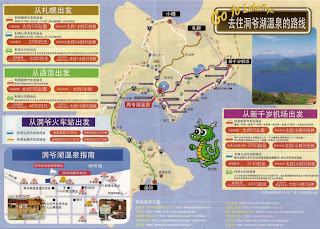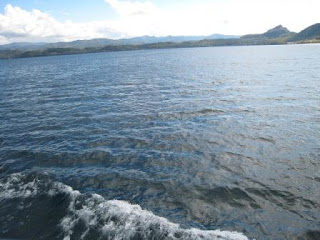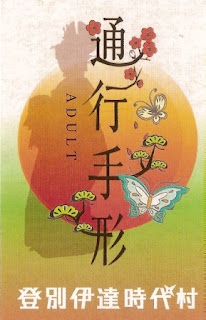Yours truly looking relaxed...(心旷神怡哟!)
Lake Toya promotional leaflet:

Our first destination for the day was the Nakajima National Forest. To get there, we were going to take a cruise ride across Lake Toya...
Another local guide would be taking us for a walk through the Nakajima National Forest - he is well-familiarised with the nature life there and holds a special license to conduct such tours. He came up with this informative handout:
My attempt at abstract art photography :) (and a few glimpses of the native deer):
The walk took slightly more than one hour. It was a refreshing change from the usual tour itinerary. We also learnt about the different types of trees, plants and the ecosystem. While waiting for the ferry to bring us back to the mainland, I took in the surrounding sights...
Bidding the Nakajima National Forest a fond goodbye...




These two photos bring to mind the song 爱如潮水 sang by 张信哲


Our next destination was an apples farm in Sobetsu. This was my first time seeing an apple tree for myself. Looks can be deceiving - I learnt that a rosy/all-red apple might not be sweet-tasting (instead there should be some yellowness on both tips of the apple). We were allowed to pick up to four apples, on condition that they be eaten onsite (ie no "tar pau"/take-away). Mine was a biggie and I couldn't even finish one. Winter would soon be coming so this was the last harvest for the farm. One of my tour mates bought a whole carton and lugged it back to Singapore.
We visited the Shikotsu-Toya National Park (支笏洞爺国立公園). As extracted from a website: "Located in south-western part of Hokkaido, Shikotsu Toya National Park consists of three separate areas, Mount Yotei, Lake Toya and Lake Shikotsu. Mount Yotei is popularly called as Mount Ezo-Fuji because its shape resembles to Mount Fuji. Lake Shikotsu, one of the most beautiful lakes in Hokkaido, is encircled by active volcanoes such as Mount Eniwa and Mount Tarumae. North and south of the lake, there are famous Jozankei and Noboribetsu spas, respectively."
"Lake Toya is a caldera lake surrounded by new volcanoes such as Mount Usu and Mount Showa-Shinzan which had risen from the plain as a result of successive eruptions since 1944. The Toyako spa is located on southern shore of the lake. The best time to see scenery and enjoy hot springs is from early summer to autumn, and hiking and camping are popular in summer season. The park provides good skiing grounds during winter season."
If there was any low point in the entire trip, this was it - Showa-Shinzan Kuma Bakujo (昭和新山熊牧场), the next tourist attraction that we went to.
The admission ticket (front and back view):
There might be some reasons why these bears are kept in captivity (eg they face extinction if left in their natural habitat). It felt miserable seeing them bounded within cement dens (with no landscaping at all to resemble their natural habitat). Their life expectency is up to about 20 years - to be constrained throughout one's life span spells plain misery to me. The real big ones are kept behind bars in individual isolation. There was one den that looked over-crowded to me and the bears kept walking round and round the enclosure. Visitors were throwing apples and biscuits at them (these are sold within the premises) and to be eating round the clock doesn't look at all good/healthy to me. My heart was so heavy that we made a quick exit.
We proceeded to visit a theme park, Noboribetsu Date Jidai Mura (登别伊达时代村, http://www.edo-trip.jp/). The streets are lined with traditional buildings modelled after the Edo period, one of the most exciting eras in Japanese history.
The entrance ticket:
The promotional brochure:
The sky was getting dark when we were about to leave...
The last tourist site that we visited for the day was Jigokudani (Hell Valley). As extracted from a website: "Jigokudani is a spectacular, appropriately named valley, which displays hot steam vents, sulfurous streams and other volcanic activities. It is one source of Noboribetsu's hot spring waters. From the valley, there are attractive hiking trails through the densely forested hills around Noboribetsu. If you follow them for about 20-30 minutes, you will get to Oyunuma, a sulfurous pond with a surface temperature of 50 degrees celsius and a smaller, even hotter mud pond nearby".
It was quite dark when we got here...
We retired for the night at the Noboribetsu Mansekikaku hotel, our second onsen hotel during the trip. Before dinner, the room was like this:
After we came back from dinner, the table was moved away and the space replaced with our "beds", tatami style. I thought I'd have a sleepless night because the mattress is so thin but it turned out to be quite comfy and I slept throughout the night :)
And this was what we had for dinner - two thumbs up!
A shot of the hotel in the following morning...





























2 comments:
now you are making me dream of Hokkaido :)
glad you finally made it there!
oh, I forgot to mention...great description n pictures!
Post a Comment